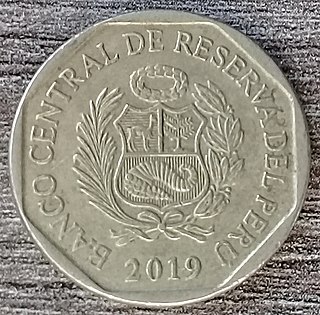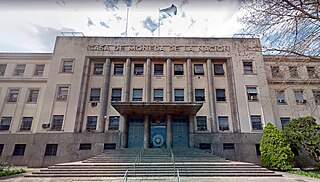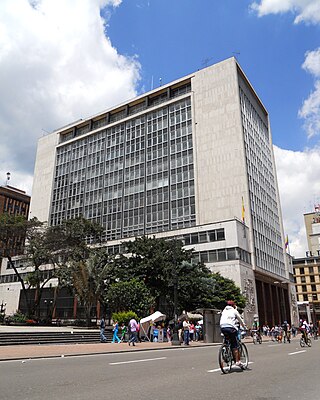
Goyeneche Palace or Casa Goyeneche is a 17th-century manorial house in the city of Arequipa, Peru. It attracts tourists interested in observing colonial architecture in Peru. Located on La Merced street, the house looks much the same as other manorial houses of those times. It has ample patios, arched ceilings, doors and windows in typical colonial baroque style as well as a balcony.

The Central Reserve Bank of Peru is the Peruvian central bank. It mints and issues metal and paper money, the sol.

The Historic Centre of Lima is the historic city centre of the city of Lima, the capital of Peru. Located in the city's districts of Lima and Rímac, both in the Rímac Valley, it consists of two areas: the first is the Monumental Zone established by the Peruvian government in 1972, and the second one—contained within the first one—is the World Heritage Site established by UNESCO in 1988, whose buildings are marked with the organisation's black-and-white shield.

Antonio Raimondi was an Italian-born Peruvian geographer and scientist. Born in Milan, Raimondi emigrated to Peru, arriving on July 28, 1850, at the port of Callao. In 1851 he became a professor of natural history. In 1856, he was one of the founding professors of the medical school at the National University of San Marcos; in 1861, he founded the analytical chemistry department.

The Casa de Moneda de México is the national mint of Mexico and is the oldest mint in the Americas.

The sol is the currency of Peru; it is subdivided into 100 céntimos ("cents"). The ISO 4217 currency code is PEN.

The real was the currency of Peru until 1863. Sixteen silver reales equalled one gold escudo. The silver coin of 8 reales was also known as the peso.
The peso moneda nacional was the currency of Argentina from 5 November 1881 to 1 January 1970, the date in which the peso ley 18.188 was issued to the Argentine public. It was subdivided into 100 centavos, with the argentino worth 5 pesos. The peso was introduced to replace the Argentine peso moneda corriente at a rate of $+m⁄c 25 = m$n 1.

The Casa de Moneda de la República Argentina is the Argentine mint, controlled by the Argentine government and administratively subordinated to the Ministry of Economy. It was established in 1875 as "Casa de Moneda de la Nación".

The Museo Casa de Moneda is a numismatics museum located in La Candelaria neighborhood of Bogotá, Colombia. It is managed by the Bank of the Republic of Colombia and used to display its numismatic collection that is composed by around 18,600 objects that include artwork, banknotes, bonds, coins, derivatives, medals, negotiable instruments, and printing instruments from various periods and regions of the world.

The Bank of the Republic is the central bank of Colombia. It was initially established under the regeneration era in 1880. Its main modern functions, under the new Colombian constitution were detailed by Congress according to Ley 31 de 1992. One of them is the issuance of the Colombian currency, the peso. The bank is also active in promoting financial inclusion policy and is a leading member of the Alliance for Financial Inclusion.

This is an outline of Uruguay's monetary history. For the present currency of Uruguay, see Uruguayan peso.

The Pre-Columbian Gold Museum is a museum in San José, Costa Rica. It is located in a subterranean building underneath the "Plaza de la Cultura" and is owned and curated by the Banco Central de Costa Rica. The museum has an archaeological collection of 3,567 Pre-Columbian artifacts made up of 1,922 ceramic pieces, 1,586 gold objects, 46 stone objects, 4 jade, and 9 glass or bead objects. The gold collection dates from 300 to 400 BC to 1550 AD. The collection includes animal figurines, amulets, earrings, erotic statuettes and several dioramas including El Guerrero, a life sized gold warrior figure adorned with gold ornaments in a glass case and a detailed scale model of a Pre-Columbian village. There is also a replica of a pre-Columbian grave containing 88 gold objects which was unearthed on a banana plantation in southeastern Costa Rica in the 1950s. In Costa Rican history, gold was considered a symbol of authority and the items are testament to the craftmanship of the Pre-Columbian period.

Armando Alba Zambrana was a Bolivian writer, journalist, historian and politician from Potosí. He won the Premio Nacional de Cultura in 1969. He was an important member of Gesta Bárbara and founded the Editorial Potosí group of writers. During the administration of President Enrique Hertzog, Alba was appointed Minister of Education and Indigenous Affairs. He was also the Bank Secretary of Potosí and the 100th anniversary of birth was celebrated in 2001.

The Royal Mint of Spain is the national mint of Spain. The FNMT-RCM is a public corporation that is attached to the Ministry of Economy.

Francisco Tudela y Varela was a French-born Peruvian diplomat, lawyer and politician. He was born in Paris, France. He graduated from the National University of San Marcos and served on its faculty. He was a member of the Civilista Party. He was Minister of Finance and foreign minister in the Government of Peru. He was 68th Prime Minister of Peru under President José Pardo y Barreda. He served as ambassador of Peru to Spain and the United States (1918–1919), and later to the Netherlands (1936). He served as President of the Chamber of Deputies (1915–1916). He served as mayor of Lima.
The Classical Monetary System of the Oriental Republic of Uruguay includes the coins minted by the Oriental Republic of Uruguay between the years 1840 and 1855 in the national territory. These coins were minted entirely within the city of Montevideo, first at the "Taller y Armería Jouve" owned by a French artisan named Agustín Jouve and later at the Casa de Moneda de Montevideo or Casa de Moneda Nacional, which was created for this purpose.

The Fábrica de Moneda is the national mint of Colombia responsible for producing coinage to conduct commerce and trade. The mint is located in the city of Ibagué and it's wholly owned and managed by the Bank of the Republic, the nation's central bank.

The Museum of the Central Reserve Bank of Peru, known also as the BCRP Museum or simply Central Museum, is an archaeological, numismatic and artistic museum of the Central Reserve Bank of Peru, located at the corners of Lampa and Ucayali streets, in the historic centre of Lima, Peru.



















